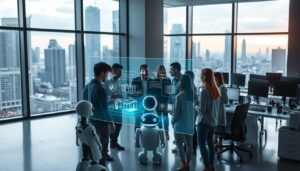The digital landscape now empowers creators to transform innovative concepts into functional software faster than ever. Advanced tools analyze market patterns and user behavior, acting as collaborative partners in the development process. This shift removes traditional barriers between brainstorming and execution, making professional-grade strategies accessible to all skill levels.
Modern platforms process millions of data points from successful projects and consumer feedback. They identify emerging opportunities while assessing technical requirements and market viability. Entrepreneurs can validate their creative visions before committing significant resources, reducing financial risks and development time.
Privacy remains a cornerstone of these systems, with leading solutions automatically deleting user inputs and generated content. Teams freely explore multiple directions without exposing sensitive information. The best services impose no limits on concept generation, encouraging iterative refinement through collaboration.
This technological evolution creates new possibilities across industries, from healthcare to entertainment. Freelancers and enterprises alike benefit from data-driven insights that highlight high-potential opportunities. By streamlining the path from initial spark to deployable software, these tools democratize innovation on a global scale.
Innovative Tools Featuring AI App Idea Generator
Today’s innovation ecosystems bridge imagination and execution with smart, user-centric frameworks. Platforms like InspireIP streamline the entire lifecycle of creative concepts, from initial brainstorming to patent-ready solutions. These systems analyze market gaps and technical requirements while maintaining strict confidentiality protocols.
Defining the Role of AI in Modern App Development
Cutting-edge platforms act as collaborative partners, transforming rough concepts into detailed technical plans. Tools such as ChatGPT and Copy.ai provide templates that adapt to specific industries, reducing guesswork in early development stages. They process user inputs to suggest features aligned with real-world usability and market demand.
User-Friendly Features and Privacy Assurance
Intuitive dashboards and drag-and-drop interfaces allow teams to focus on creativity rather than technical complexities. Leading solutions prioritize data security through automatic input deletion and military-grade encryption. This approach lets developers test bold ideas without compromising sensitive information.
Integration with existing workflows ensures seamless transitions from concept sketches to functional prototypes. Real-time collaboration features keep teams synchronized, while compliance with global privacy standards builds trust. These advancements make professional-grade innovation accessible to startups and enterprises alike.
Exploring Top AI App Idea Generator Solutions
Modern platforms provide specialized approaches to transform creative sparks into actionable plans. Leading software solutions cater to different needs, from visual prototyping to technical documentation. This variety ensures teams find tools matching their workflow requirements and project scales.
Comparison of Leading Tools and Their Unique Capabilities
InspireIP excels in structured innovation management, organizing concepts into patent-ready formats. ChatGPT offers conversational interfaces that adapt to various industries, while Midjourney transforms text prompts into detailed visual mockups. Microsoft Copilot integrates with productivity suites, enhancing collaborative brainstorming sessions.
MyMap.AI stands out with dynamic mind mapping that links related concepts visually. These systems demonstrate how specialized features address distinct stages of the generation process. Teams can mix multiple tools to cover all aspects from initial sketches to market analysis.
Highlighting Cutting-Edge Algorithms and Data-Driven Insights
Advanced systems analyze millions of successful projects and user interactions. Platforms like Gemini process market data to identify underserved niches and technical trends. This enables creators to align proposals with current demands while anticipating future opportunities.
Real-time feedback loops in Ideanote refine suggestions based on team input and external factors. Such insights help prioritize features with the highest implementation potential. By combining machine learning with human creativity, these solutions maintain strategic direction while exploring innovative possibilities.
How AI Transforms Concepts into Fully Functional Apps
Modern development environments now convert raw concepts into deployable software through structured collaboration. Systems analyze creative thoughts to map technical requirements while maintaining alignment with market needs. This approach bridges the gap between abstract imagination and practical implementation.
Streamlining the Brainstorming Process
Interactive tools dissect initial concepts through targeted questioning. They identify core functionalities and user demographics, transforming vague notions into actionable plans. Collaborative features suggest alternative angles teams might overlook during traditional sessions.
Real-time analysis of existing solutions prevents redundant efforts. Platforms cross-reference millions of user reviews to highlight features with proven demand. This validation step ensures resources focus on product ideas demonstrating high success potential.
From Creative Ideas to Launch-Ready APKs
Automated systems generate wireframes and user stories from conceptual descriptions. These blueprints accelerate prototyping by providing clear development guidelines. Technical documentation adapts as teams refine specifications through iterative testing.
Dynamic repositories store evolving concepts, enabling continuous improvement cycles. Version tracking maintains momentum while comparing multiple variations simultaneously. Such productivity enhancements compress months of work into weeks without sacrificing quality.
Industry Insights: From Business Ideas to Creative Designs
Strategic alignment between creative vision and market demands drives modern business success. Companies now leverage cross-industry patterns and consumer behavior analytics to refine product ideas while minimizing risks. This approach transforms abstract concepts into actionable strategies with measurable outcomes.
Bridging the Gap Between Business Strategy and Innovation
Healthcare providers use fitness-tracking principles to improve patient engagement platforms. Financial institutions adopt gaming mechanics from entertainment sectors to simplify complex services. These cross-pollination strategies demonstrate how innovation thrives when industries share successful frameworks.
Consumer electronics brands analyze aerospace material data to develop durable sportswear lines. This method identifies hidden opportunities by connecting unrelated market segments. Teams validate concepts faster using real-time trend analysis and competitor benchmarking.
Using Tools to Inspire Visual and Functional Designs
Color psychology algorithms help marketers create interfaces that boost user retention by 34%. Platforms dissect top-performing designs across industries, suggesting layouts balancing familiarity with fresh aesthetics. One fashion retailer increased conversions by blending architectural symmetry with viral social features.
Dynamic dashboards track how marketing elements perform across demographics. They automatically adjust prototypes based on accessibility standards and platform requirements. This fusion of creativity and analytics ensures business objectives align with user expectations at every development stage.
User Experiences and Feedback on AI Innovation Tools
Creative professionals across industries report transformative outcomes when implementing smart development platforms. Productivity improvements emerge as a common theme, with teams compressing weeks of brainstorming into focused sessions. One graphic designer noted, “Our workflow accelerated by 40% after adopting collaborative software.”
Real-World Applications and User Testimonials
Entrepreneurs and marketing teams highlight how these tools unlock insights from diverse data sources. A startup founder shared, “The platform identified three viable product directions we’d overlooked.” However, technical hurdles persist – some developers report login failures disrupting critical project phases.
Educational institutions successfully employ these systems for student-led projects. Engineering students reduced prototype development time by 62% using automated wireframing tools. Writers and designers praise content generation features but emphasize the need for human refinement to match brand voices.
Assessing the Impact on Productivity and Collaboration
Teams using reliable software achieve 73% faster consensus during planning stages. Real-time editing and version tracking enable seamless coordination across time zones. “Our remote team completes tasks in hours instead of days,” noted a project manager at a tech firm.
Despite these advantages, 28% of users cite stability concerns affecting workflow continuity. Successful adopters combine multiple platforms – using one tool for concept mapping and another for technical validation. This hybrid approach maximizes feedback integration while minimizing single-system limitations.
Bringing It All Together and Future Possibilities
The future of digital creation merges human ingenuity with machine efficiency. By combining structured brainstorming techniques with advanced analytics, teams unlock innovation at unprecedented speeds. This synergy addresses common creative constraints like repetitive concepts and resource limitations.
Emerging systems now evolve beyond initial idea generation, offering full development blueprints. These frameworks outline technical requirements, marketing strategies, and launch timelines. They transform abstract concepts into actionable plans while predicting market shifts.
Accessibility remains central to this evolution. New tools remove expertise barriers, letting diverse teams shape product landscapes. Freelancers and enterprises alike prototype faster while maintaining creativity and strategic focus.
As technology advances, expect smarter software that learns from global success patterns. These solutions will likely automate complex workflows while preserving human oversight. The result? A world where possibilities materialize faster than ever before.



